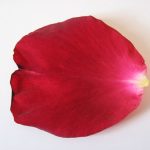 A single, usually free, unit of a completely divided corolla or second floral whorl (keel petals in many papilionoid legumes are partially fused/united along their lower margins).
A single, usually free, unit of a completely divided corolla or second floral whorl (keel petals in many papilionoid legumes are partially fused/united along their lower margins).
A member of the inner set of floral leaves, usually colored or white and serving to attract pollinators.
Free segment of the corolla.
The leaflike parts of a flower that are usually brightly colored and enclose the reproductive organs (compare with “sepals” and “tepals”).
One of the parts of the corolla, usually colored.
One member of the arrangement of flower parts forming the corolla.
A leaf of the corolla; usually bright-colored.
A nonreproductive flower part, often leaflike, white, or colored, situated above the sepals. Petals may be separate (free) or fused in various ways forming a tube.
Leaflike, often brightly colored, segment of the corolla.
One of the segments of the corolla, usually colored.
One of the inner whorl of floral leaves (usually white or coloured) that surround the stamens and/or carpels of a flower.
The colorful part of most flowers. Petals are in fact modified leaves, and there are some flowers that have green petals, for example the green zinnia ‘Envy’.
An individual segment or part of the corolla, often brightly colored.
One of the second set of appendages of a flower, usually the showy part. Example, the colorful part of a rose flower.
The whorl of enclosing organs of a flower that comes between sepals and stamens; the most colorful and conspicuous part of most flowers. The petals collectively form the corolla.
An inner flower leaf, usually brightly coloured and showy; the petals collectively form the corolla.
Typically vibrant but occasionally green, these structures are the most noticeable part of the flower.
